9. Entrepreneurship training
Introduction
Description:
This module is designed to equip youth center professionals with the knowledge, tools, and pedagogical approach needed to ignite the entrepreneurial spirit in unaccompanied refugee minors. It promotes entrepreneurship as a tool for inclusion, empowerment, and long-term integration, whether through economic self-sufficiency, community engagement, or self-expression.
Grounded in the EntreComp framework and guided by best practices from entrepreneurship education, the module provides a structured yet flexible curriculum to help youth workers support minors in discovering their interests, spotting opportunities, building confidence, and transforming ideas into viable micro-projects or initiatives.
Participants will learn to facilitate this process through coaching, experiential methods, digital tools, and context-sensitive strategies that reflect the reality of displacement, legal uncertainty, and vulnerability many minors face. The module supports professionals to become inclusive mentors, facilitators, and enablers of entrepreneurial exploration.
The module is aligned with the Safe Spaces programme objectives, contributing to psychosocial development, career readiness, and integration through culturally sensitive, participatory, and creativity-driven methods.
Aim:
The aim of this module is to empower youth center professionals such as social science students and third-sector and youth workers to stimulate entrepreneurial thinking and action among unaccompanied refugee minors by:
- Providing them with practical tools and pedagogical strategies to facilitate entrepreneurial learning
- Supporting youth in exploring their identity, potential, and purpose through structured self-reflection and project-based work
- Enabling the design and facilitation of safe, inclusive, and culturally sensitive spaces for creativity, initiative, and co-creation of them.
- Equipping staff with the ability to guide youth from idea generation to the launch of micro-initiatives, whether social, artistic, or commercial.
- Promoting digital inclusion among professionals and minors and the use of digital tools for collaboration, project development, and enhance their visibility in the entrepreneurial ecosystem.
This training also helps staff integrate entrepreneurship as a mindset, not just a business practice—preparing minors for future pathways in education, employment, and civic engagement.
Learning outcomes:
By the end of this module, youth center professionals will be able to:
- Explain the core concepts of entrepreneurship, social entrepreneurship, and agile innovation within the context of youth empowerment and integration.
- Recognize the specific barriers and opportunities unaccompanied refugee minors may face in entrepreneurial exploration.
- Facilitate structured processes that help young people identify personal interests, talents, and community needs.
- Guide youth through ideation techniques and help them generate and evaluate multiple creative solutions to real-world problems.
- Support minors in the development of simple prototypes or minimum viable projects using appropriate tools.
- Coach youth in presenting, testing, and refining their ideas with real users or community members.
- Navigate digital tools for communication, project planning, and business modeling in inclusive and accessible ways.
- Promote soft skills such as self-efficacy, initiative-taking, teamwork, and cultural empathy through. entrepreneurship-related activities
- Adapt entrepreneurship learning experiences to national legal contexts, available public resources, and the psychosocial needs of minors.
Why entrepreneurship?
Entrepreneurship is more than launching a business. It is a mindset, a form of personal empowerment, and a way of creating value for oneself and others. For unaccompanied refugee minors, it becomes a vehicle for belonging, voice, and self-determination—especially when traditional educational and employment paths may be delayed, interrupted, or unclear.
Introducing entrepreneurship in youth center settings helps:
- Build self-confidence and purpose through identity exploration and value creation
- Foster agency in youth who have experienced instability, disempowerment, and exclusion
- Encourage civic participation by designing initiatives that respond to real needs in the host community
- Strengthen soft skills: collaboration, problem-solving, adaptability, and digital literacy
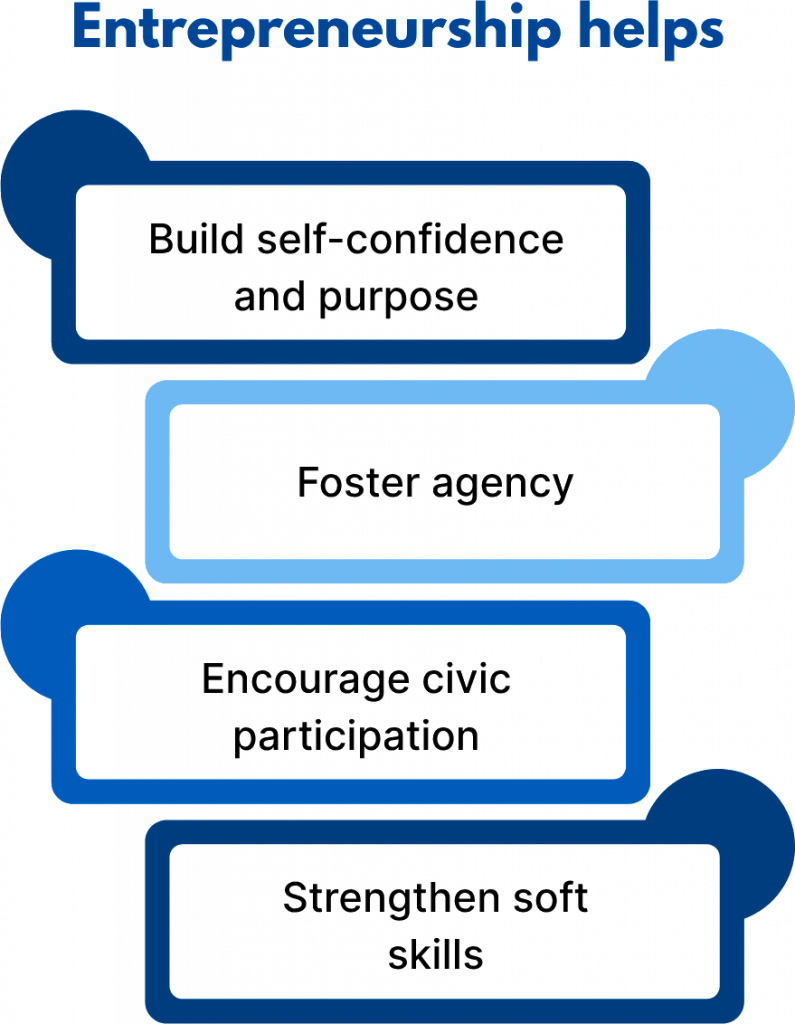
Even if no business is launched, the process of entrepreneurial thinking cultivates resilience, initiative, and future-orientation.
What are the values behind this approach?
The entrepreneurship approach in this module is guided by the following core values:
- Empowerment over dependency – building pathways to self-sufficiency
- Inclusion over assimilation – valuing diverse identities and perspectives
- Participation over passivity – youth as creators, not just beneficiaries
- Exploration over expectation – giving space for trial, error, creativity
- Community over competition – encouraging collaboration and mutual support
Key considerations
Key considerations while introducing entrepreneurship to unaccompanied refugee minors
It’s essential that youth center staff understand the specific vulnerabilities, legal constraints, and psychosocial dynamics at play when fostering entrepreneurship with unaccompanied refugee minors.
Entrepreneurship can be a powerful catalyst for growth, integration, and self-expression. But when working with unaccompanied refugee minors, youth professionals must approach the topic with cultural sensitivity, trauma-awareness, and legal clarity. Below are key considerations to keep in mind:
1. Legal and Institutional Constraints
Unaccompanied minors may have:
- Unclear or changing residence status that affects their ability to work or open a business
- Limited access to banking, identification, or online tools required for formal entrepreneurship
- Lack of parental/legal guardianship, which restricts signing contracts or registering a company
The goal is not necessarily formal business creation. The focus should be on entrepreneurial thinking and project-based action that builds confidence, collaboration, and initiative — with flexibility to adapt to each minor’s legal reality.
2. Uneven Educational Backgrounds
Minors may range from having:
- High levels of education in their home country
- Interrupted or no formal education at all
- Limited literacy (including in their own language)
Activities should be visual, practical, participatory, and non-text-heavy. Tools like canvases, storytelling, and drawing help level the field.
3. Language and Communication Barriers
Language fluency varies. Many minors are still acquiring the local language or lack business-specific terminology in both the native and host country languages.
Use simple, translated, or visual tools. Encourage bilingual peer collaboration and integrate language learning organically into entrepreneurship activities.
4. Trauma and Psychosocial Challenges
Many unaccompanied minors:
- Carry trauma from conflict, displacement, or loss
- Experience isolation, anxiety, or mistrust of institutions
- Are in survival mode, prioritizing immediate stability over abstract future planning
Avoid pressure to perform. Frame entrepreneurship as a way to explore identity, express oneself, and take small steps toward the future. Provide space for emotional processing, and always align with existing mental health support.
5. Cultural Concepts of Work and Success
Minors come from diverse cultural contexts where:
- The concept of “starting a business” may feel distant or unfamiliar
- There may be gender norms limiting perceived roles in economic life
- Entrepreneurship may be seen as either a last resort or a status marker
Use culturally inclusive examples and role models. Encourage youth to define success on their own terms — whether that’s a social initiative, creative expression, or community micro-project.
6. Motivation: Not Always Financial
For many minors, entrepreneurship is not about profit. It’s about:
- Belonging
- Purpose
- Contribution
- Self-worth
Validate non-commercial projects (e.g. organizing a community event, launching a peer support group, running a cooking club). These are powerful entrepreneurial acts.
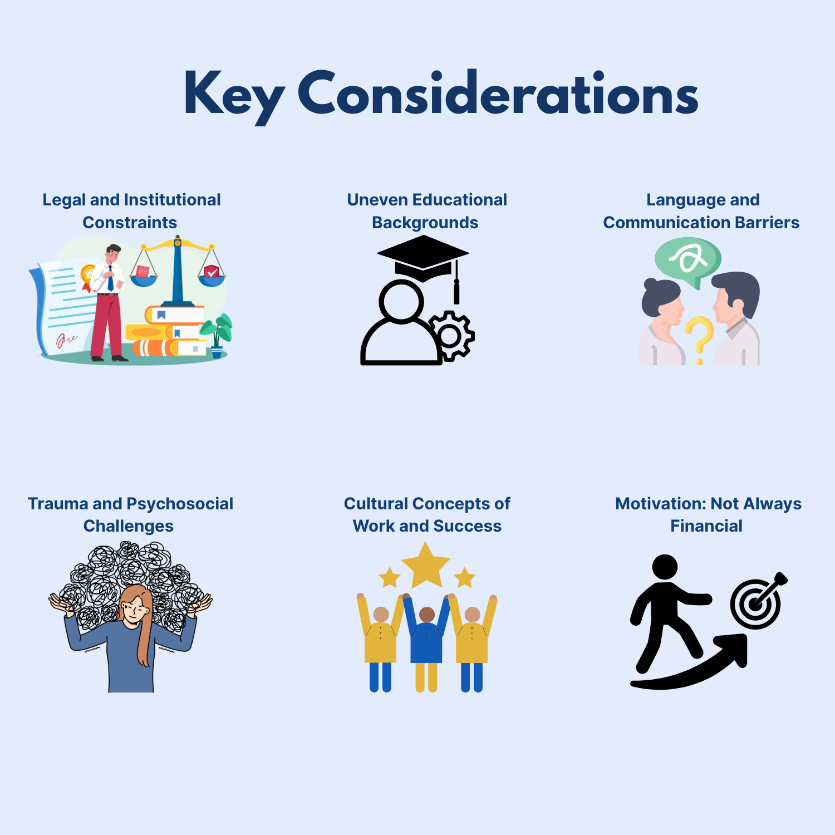
The 7-Step Process of Igniting Entrepreneurship
The process used in this module reflects a learning-by-doing and coaching-based approach and mirrors agile startup principles adapted for youth work:
- Introduction to Entrepreneurship – Cultivating a “yes, I can” mindset and learning the landscape
- Understand – Exploring problems and user needs through empathy and curiosity
- Ideate – Generating creative solutions without fear of judgment or failure
- Decide – Evaluating ideas and choosing one to develop further
- Prototype – Building a minimum viable version of the idea
- Test – Getting feedback from real people and making changes
- Launch – Taking formal or informal steps to implement the idea in real life
Each step is structured around conversation, reflection, co-creation, and accessible tools, so staff can adapt it to the language, maturity, and legal context of the youth they work with.
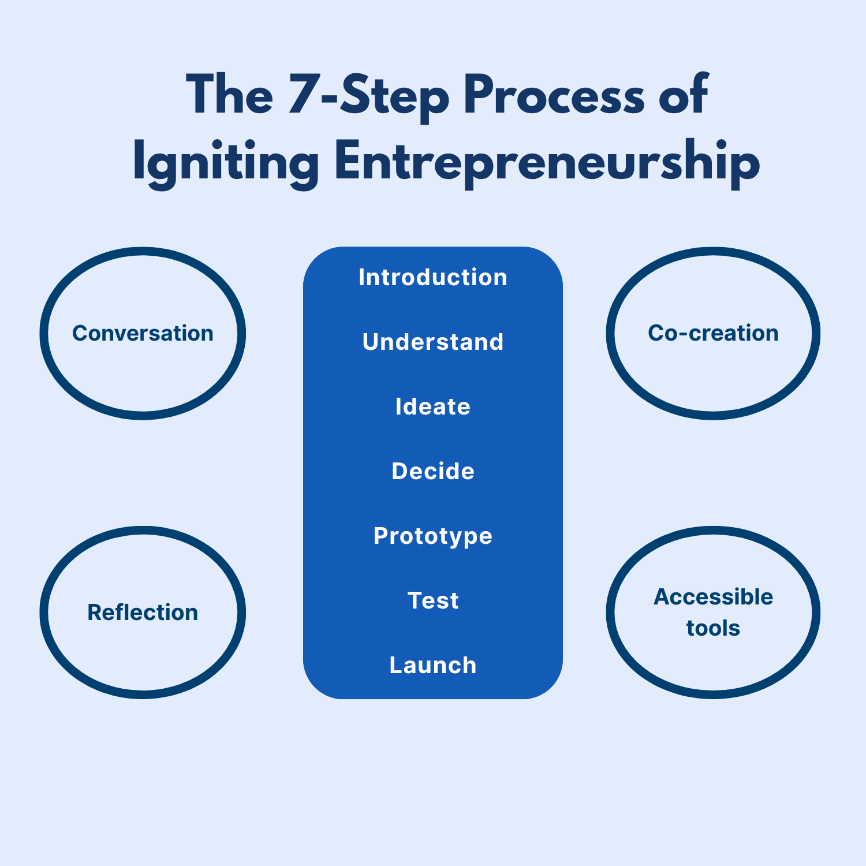
Introduction to Entrepreneurship
Entrepreneurship is often associated with launching a business, but in the context of youth work and integration, it is better understood as a way of thinking, acting, and creating value. This module invites youth center professionals to frame entrepreneurship not only as a career path but also as a vehicle for personal growth, expression, and contribution to the host society.
In this sense, entrepreneurship is not only for those with capital or experience—it is accessible to every young person, including those navigating complex situations like displacement, uncertainty, or legal limitations.
Key Concepts to Introduce to Youth
- Entrepreneurial Mindset: The ability to spot opportunities, take initiative, learn from failure, and adapt to change.

- Social Entrepreneurship: Creating value for others, not just profit—for example, starting a recycling project, organizing a peer-support group, or creating cultural exchanges.

- Digital Entrepreneurship: Using digital tools (like Canva, Instagram, or Google Forms) to share, collaborate, and even create mini-ventures online.

- Agile Innovation: Building ideas step by step—trying out small versions (prototypes), getting feedback, and improving quickly.

- “It is possible” Attitude: The most crucial foundation. Before any tools or techniques, youth must feel: “I have the right and ability to create something new—even if small.”
Suggested Approach for Youth Workers
Start by activating curiosity and self-belief. Use inspirational stories, role models, or group dialogue to help minors:
- Identify what excites them and create a safe space for open sharing and trust
- Reflect on people who inspire them and why
- Visualize what kind of entrepreneurial idea could concretely they would like to build
Use tools such as:
- The Dream Life Canvas – where youth describe their desired future and role in it
- The World Shift Canvas – to help compare their current situation with their aspirations
- Storytelling circles – where youth tell or draw stories of overcoming a challenge or making something new happen
These reflective tools allow minors to start thinking of entrepreneurship not as a faraway goal but as something personal, human, and rooted in their everyday lives.

Real-Life Case Example
Sara, a 17-year-old from Afghanistan, began the entrepreneurship workshop unsure of what she could offer. After several sessions, she shared her love of drawing and her dream of becoming a designer. With support from staff, she created a small Instagram account to showcase her art and take simple commissions for digital portraits. Though informal, this activity gave Sara a sense of purpose, validation, and visibility in her host community.
Tips for Youth Workers
- Avoid “business jargon” in early sessions
- Focus on confidence, curiosity, and connection before revenue, models, or plans
- Reinforce progress, not outcomes
- Always co-create: ask, listen, reflect together
Questions for self-reflection
Preparation Questions for Youth Workers
Self-reflection is an important part of this course because it helps participants think about their experiences and how they have grown. By taking time to reflect, individuals can better understand not only the current topic, but also their strengths, challenges, and what drives them. This process boosts self-awareness and encourages the use of what they’ve learned in real-life situations, supporting their personal and professional growth.
To be done beforehand as a self reflection for the Youth Worker.

Part 1
- What do you believe entrepreneurship means—for you and for the minors you work with?
- Have you ever created something new that made a difference for someone? How can you share that story?
- What fears might minors have about entrepreneurship? How can you help reframe them?

Part 2
- What does “creating something new” mean to me?
- Who inspires me, and what have they created that I admire?
- What kind of life would I like to build for myself?
- How do I feel when I imagine myself as a leader or changemaker?
Understand — Identifying Problems and User Needs
Overview
The first step in building any initiative—whether a social project, a service, or a business—is to deeply understand the context: What problems exist? Who is affected? What are their needs?
For unaccompanied minors, this stage is a powerful opportunity to explore what’s broken in the world around them, reflect on what matters to them, and begin to see themselves as active participants in change.
Key Competencies for Youth
- Empathy – The ability to understand the feelings, needs, and challenges of others
- Observation – Paying attention to what works, what doesn’t, and why
- Listening – Asking the right questions and being open to diverse perspectives
- Problem Framing – Turning vague complaints into solvable challenges
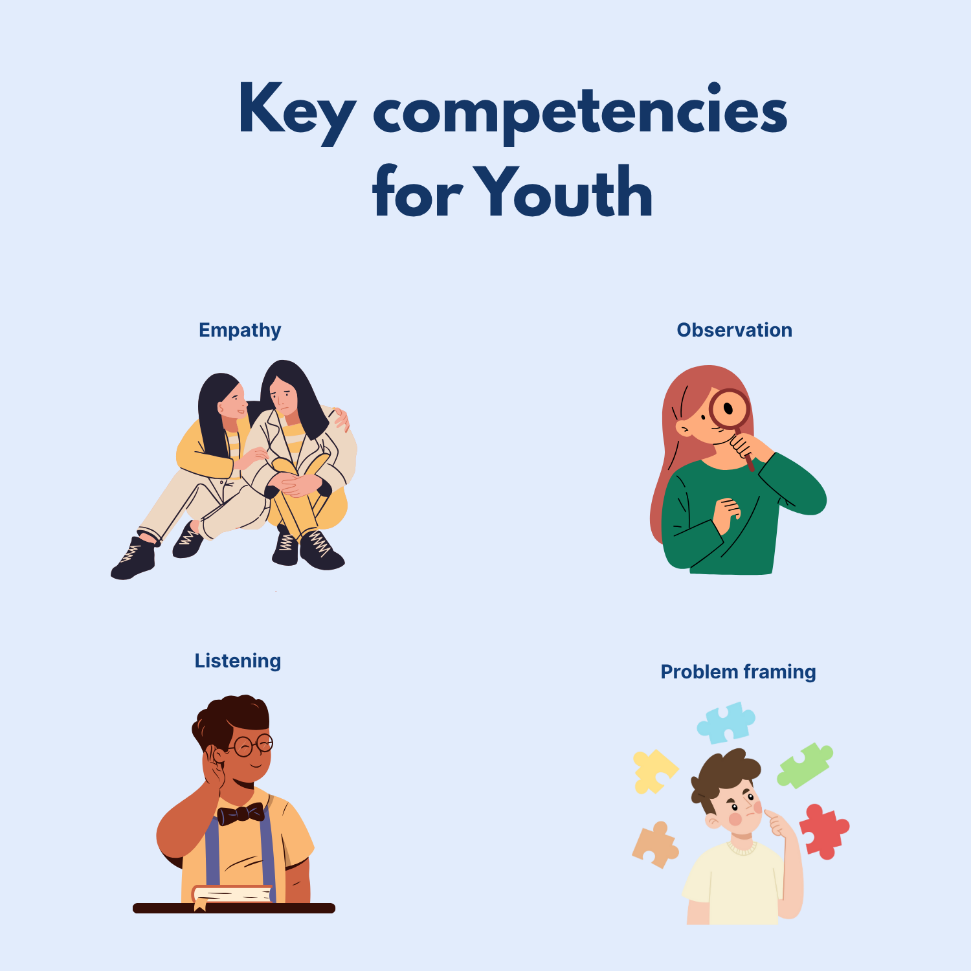
Tools and Methods
Use visual and discussion-based methods to engage youth in a safe and inclusive way:
- Identify Canvas – A structured worksheet for exploring frustrations and feeling of social exclusion/inclusion in society, school, or daily life
- Observation Walks – Go outside and observe: what’s missing in the community? What could be better?
- Empathy Interviews – Talk to peers or staff and ask: What is something that really bothers you? What would help?
- “What if…?” Boards – Have youth complete statements like “What if there were a way to…?”
This stage should encourage curiosity, not push solutions too fast.
Group Activity Example:
Ask the group to make a “Wall of Problems”:
- Each person writes 2–3 things they think don’t work well in their community or daily life and how these can be improved through an entrepreneurial idea.
- As a group, cluster similar issues and discuss: Who is affected? Why does it matter?
This activity builds awareness and shows that every idea starts with a problem someone cares about.
It is an early stage for solutions. Check Ideation where they are to find solutions for the Frustrations.
This is a warm-up, so it is not necessary to have already found solutions.

Real-Life Case Example
Jamal, a 16-year-old from Sudan, noticed that many other minors in his shelter felt isolated and bored. Through group exercises, he reframed this observation into a problem: “There is no space where we can relax and share our culture.” This became the seed for a youth-led weekly cultural sharing night, co-organized with the youth center.
Special Considerations for the Target Group
- Many minors may have difficulty articulating needs due to trauma, language barriers, or lack of trust
- Encourage them to start with their own entrepreneurial experiences before asking about others
- Let youth draw, roleplay, or act out scenarios to help express insights
Questions for self-reflection
Preparation Questions for Youth Workers
Self-reflection is an important part of this course because it helps participants think about their experiences and how they have grown. By taking time to reflect, individuals can better understand not only the current topic, but also their strengths, challenges, and what drives them. This process boosts self-awareness and encourages the use of what they’ve learned in real-life situations, supporting their personal and professional growth.
Reflection Questions for Youth Workers

Part 1
- How can you create space for minors to feel safe sharing problems without fear of judgment?
- In what ways can you model active listening and empathy?
- How can you help minors move from personal frustration to community-oriented thinking?

Part 2
- What problems or challenges do I notice around me?
- Who do I care about helping, and why?
- When have I felt something was unfair or missing? What could be done about it?
- How does listening to others’ stories help me see new needs?
- What can I do about it, in the sense what talents/resources i already have that i can put in place to resolve/provide a solution for the frustration?
Ideate — Generating Creative Solutions
Overview
Once young people have identified a challenge or unmet need, or a possibility to upgrade an existing initiative (by identifying a gap that they can cover) the next step is to generate multiple possible solutions. This phase is not about choosing the “right” idea immediately—it’s about expanding possibilities through playful thinking, imagination, and confidence.
For unaccompanied minors who may feel limited by their legal status, economic resources, or past experiences, this stage is crucial in showing that creativity is power—and that there are always more ways to make a difference than first assumed.
Key Competencies for Youth
- Creativity and Imagination – Thinking beyond limitations and norms
- Openness – Suspending judgment to allow new ideas to emerge
- Collaboration – Building ideas together, adding to others’ input
- Resilience – Learning to generate ideas without fear of being “wrong”
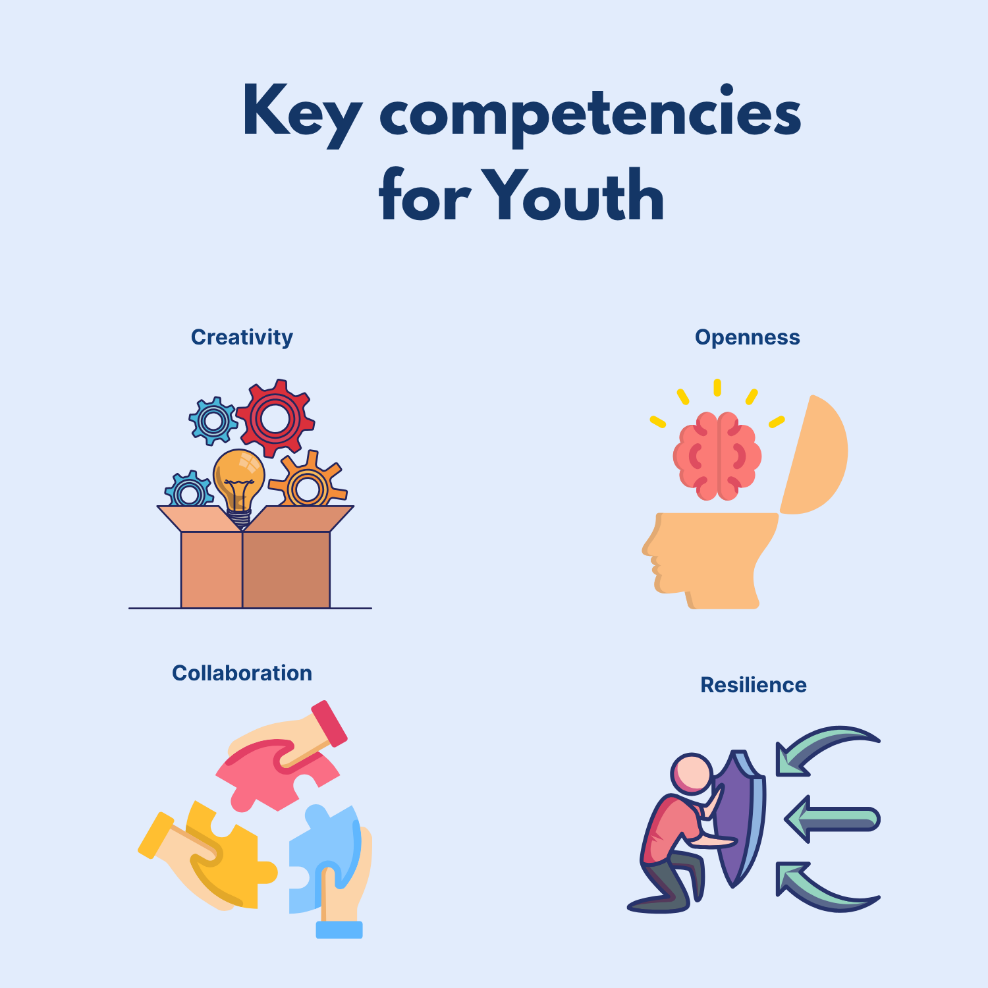
Tools and Methods
Use energizing, participatory formats to help youth express ideas freely:
- Brainstorming with Rules – E.g., “No idea is too silly”, “Quantity over quality”, “Build on others’ ideas”
- Mind Maps – Use visuals to connect problems to possible solutions
- Crazy 8s – Have youth sketch 8 solutions to a problem in 8 minutes—no matter how wild
- “If I had a magic wand…” – Encourage imaginative, no-limits responses as a warm-up
Structure activities so that even the quietest voices are heard, for example by using sticky notes or small group circles.
Group Activity Example: Idea Storm
- Take one problem from the group’s earlier work (e.g. “No way to relax and meet others”)
- Set a timer for 10 minutes and have everyone write or draw as many ideas as possible
- Cluster the ideas by theme (e.g. events, digital tools, space redesign, peer groups)
- Let the group vote for the top 2–3 ideas to explore further
This promotes co-creation and ownership while respecting diverse thinking styles.

Real-Life Case Example
Lina, age 15 from Syria, wanted to help other girls feel safer at the shelter. In the ideation phase, her group proposed ideas ranging from a self-defense workshop, to a peer hotline, to a “calm corner” for stress relief. Though not all ideas were pursued, the process helped Lina realize she didn’t need to choose between creativity and caring—she could do both.
Tips for Youth Workers
- Praise the process, not just the ideas
- Use humor and playfulness to reduce fear of being wrong
- Invite staff or peers to join in idea generation to create an open environment
Questions for self-reflection
Preparation Questions for Youth Workers
Self-reflection is an important part of this course because it helps participants think about their experiences and how they have grown. By taking time to reflect, individuals can better understand not only the current topic, but also their strengths, challenges, and what drives them. This process boosts self-awareness and encourages the use of what they’ve learned in real-life situations, supporting their personal and professional growth.
Reflection Questions for Youth Workers

Part 1
- How do you help minors shift from “we can’t” to “what if we could…”?
- Are you comfortable letting ideas be incomplete or messy at this stage?
- What cultural or gender norms might affect whose ideas get heard—and how can you address this?

Part 2
- What ideas do I have that could help someone?
- Which ideas make me excited to try them?
- What whould I do if I had no fear of being wrong?
- What surprised me when I started imagining new possibilities?
Decide — Choosing and Prioritizing Ideas
Overview
After generating a range of creative ideas, the next step is to narrow down the options and select one idea to develop further. This stage introduces minors to the concepts of decision-making, feasibility, and prioritization—skills they may not have practiced in group or project settings before.
The goal is not to pick a perfect idea, but to commit to testing one that feels meaningful, realistic, and doable. Staff should support youth in navigating this process with a sense of ownership, without feeling judged or discouraged.
Key Competencies for Youth
- Critical thinking – Evaluating the pros and cons of different ideas
- Strategic decision-making – Choosing ideas that balance vision and realism
- Confidence – Trusting their voice and perspective in choosing a direction
- Responsibility – Owning the choice and its next steps
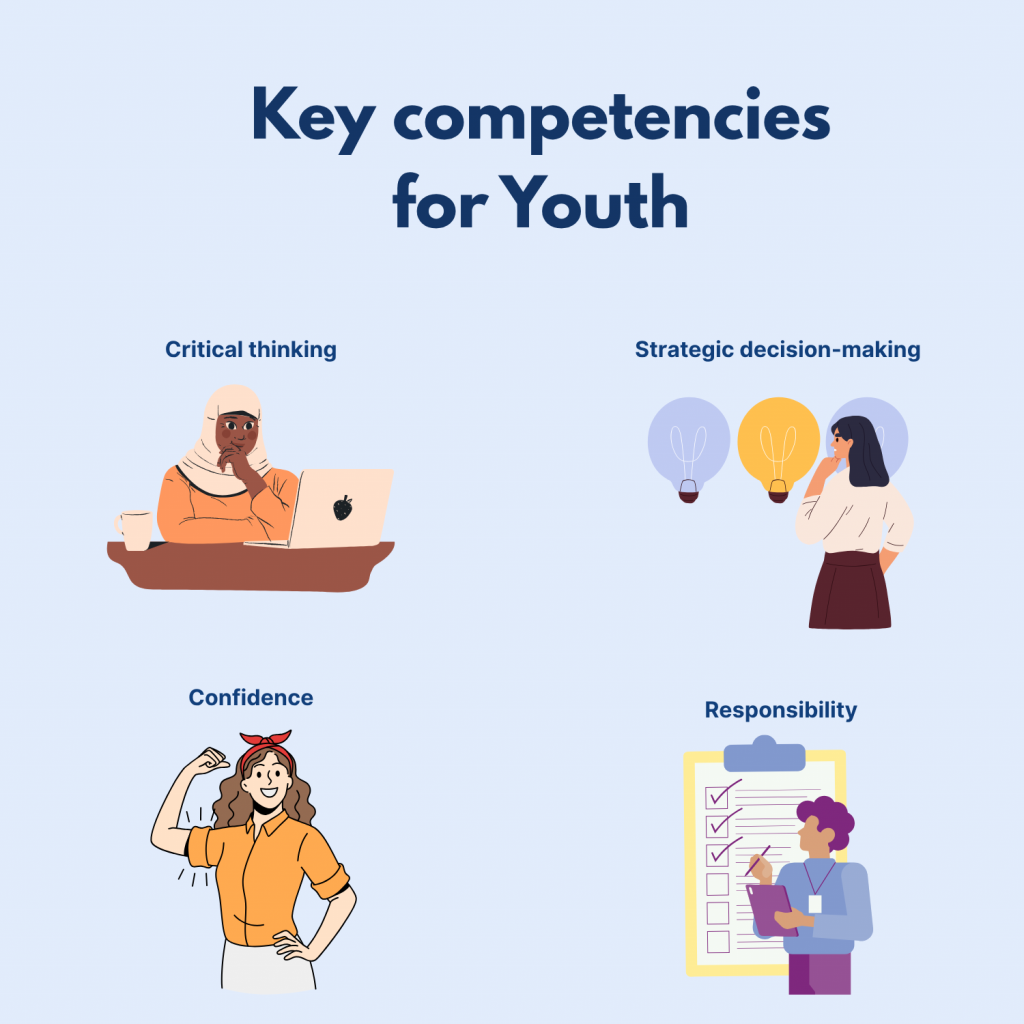
Tools and Methods
- Dot Voting – Each participant votes on their top 1–2 ideas; tally to see group preferences
- Feasibility-Impact Matrix – Plot ideas on a 2×2 grid: How easy vs. how impactful?
- Decision Canvas – Guide minors to assess ideas by asking:
- Does this idea matter to me or my peers?
- Can we try it with the time, space, and support we have?
- What resources would we need?
- Is there anyone we could ask for help?
- Pitch Circles – Youth briefly present their ideas to others for feedback, then revise
Group Activity Example: Idea Prioritization Workshop
After initial brainstorming, have groups or individuals score each idea on:
- Motivation (Do we care?)
- Feasibility (Can we try it with what we have?)
Inclusivity (Can others join or benefit?)
Discuss together and then choose 1–2 ideas to move forward with.
This reinforces shared decision-making and reduces fear of failure.

Real-Life Case Example
Amin, 17, and his peers wanted to address food waste and hunger. They had several ideas—from a mobile app to a community fridge. Through prioritization tools, they realized a “leftover-sharing box” at their shelter was the most feasible starting point. The decision made them feel empowered: “We can actually start this tomorrow.”
Special Considerations for the Target Group
- Minors may worry about making the “wrong” choice—emphasize that the process is iterative
- If minors disagree on which idea to pursue, allow parallel tracks or mini-projects if possible
- Normalize scaling down ideas without losing their essence (e.g. from online store → display table at a community event)
Questions for self-reflection
Preparation Questions for Youth Workers
Self-reflection is an important part of this course because it helps participants think about their experiences and how they have grown. By taking time to reflect, individuals can better understand not only the current topic, but also their strengths, challenges, and what drives them. This process boosts self-awareness and encourages the use of what they’ve learned in real-life situations, supporting their personal and professional growth.
Reflection Questions for Youth Workers

Part 1
- How can you support minors to make confident decisions without fear of failure?
- Do your activities allow for flexibility if a decision needs to change later?
- How do you balance group consensus with individual voice?

Part 2
- What makes me want to choose this idea?
- What challenges might I face if I try this?
- What support would help me feel more confident moving forward?
- If this idea works, how could it help others?
Prototype — Building a Minimum Viable Version (MVP)
Overview
Prototyping is about bringing an idea to life in a simple, low-risk way. It means creating a rough, testable version of the idea—not the final product. For unaccompanied minors, this step reinforces the message: “You don’t need perfection to start. You need a first version.”
By making ideas tangible, prototyping boosts confidence, builds problem-solving skills, and helps youth see progress with their own eyes.
Key Competencies for Youth
- Taking initiative – Moving from plan to action
- Experimentation – Trying things out and learning by doing
- Adaptability – Adjusting ideas based on what works
- Resourcefulness – Making the most of what’s available
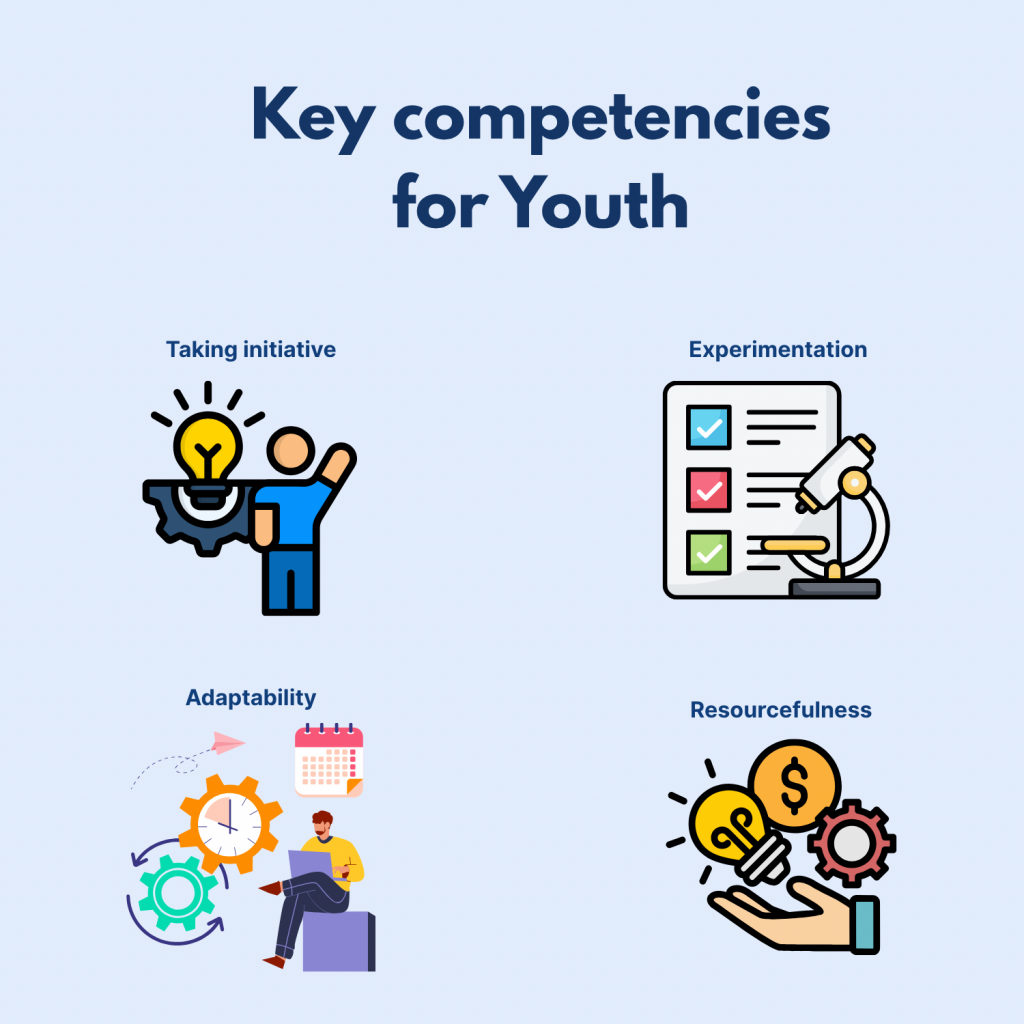
What Can a Prototype Look Like?
A prototype doesn’t need to be physical or expensive. It could be:
- A flyer for an event
- A social media post or mock Instagram account
- A simple landing page or slideshow
- A model or drawing
- A script for a peer-education video
- A trial run of an activity, like a shared meal or talent show
Encourage the mindset: “Try small, test smart.”
Tools and Methods
- Business Model Canvas (Youth-Friendly Version) – Helps sketch the key elements of the initiative: who, what, how, and why
- Happy Startup Canvas – For values-based projects (especially useful for social or cultural initiatives)
- Craft Your Pitch Canvas – Guides youth in summarizing their idea into a short, clear message
- Digital Mockups – Use free tools (like Canva or Google Slides) to simulate a brand, invitation, or digital presence
- Storytelling your idea
- Elevator pitch
Group Activity Example: “Build in a Day” Challenge
- Set a 2–3 hour window where youth create their MVPs
- Offer materials: cardboard, markers, laptops, phones, props
- End with a show-and-tell circle where each youth presents what they built
- Celebrate process, not polish!
This builds momentum and excitement while reinforcing that real progress is possible.

Real-Life Case Example
Leyla, 16, developed an idea for a peer storytelling night. With her group, she made a basic flyer, a script, and a floor plan for how the room would look. They practiced the introductions, invited peers, and ran a pilot event with five attendees. This “small launch” helped Leyla discover her voice as a community organizer.
Tips for Youth Workers
- Don’t wait for perfect conditions—encourage prototyping with what’s already available
- Use supportive language: “Let’s try,” “This is a first draft,” “It’s okay to pivot”
- Offer feedback that is constructive, not corrective
Questions for self-reflection
Self-reflection is an important part of this course because it helps participants think about their experiences and how they have grown. By taking time to reflect, individuals can better understand not only the current topic, but also their strengths, challenges, and what drives them. This process boosts self-awareness and encourages the use of what they’ve learned in real-life situations, supporting their personal and professional growth.
Reflection Questions for Youth Workers

Part 1
- What can you do to make “prototyping” feel exciting, not intimidating?
- How can you encourage youth to be proud of imperfect but real results?
- What low-cost materials or digital tools do you already have that can support prototyping?

Part 2
- What was it like to build the first version of my idea?
- What did I enjoy the most? What felt difficult?
- How did I feel showing my work to someone else?
- What skills did I use or learn while doing this?
Test — Getting Feedback and Iterating
Overview
Testing is the phase where youth share their prototype with real people—peers, youth workers, community members—and learn from their reactions. It is a vital step that reinforces the principle: “You learn by doing and improve by listening.”
For unaccompanied minors, this process strengthens social interaction, communication, and the ability to receive feedback with curiosity instead of fear. It also deepens their belief that what they create can matter to others.
Key Competencies for Youth
- Listening and communication – Asking open questions, receiving feedback
- Iterative thinking – Willingness to revise and improve an idea
- User focus – Creating something useful or meaningful to others
- Resilience – Understanding that negative feedback is part of growth
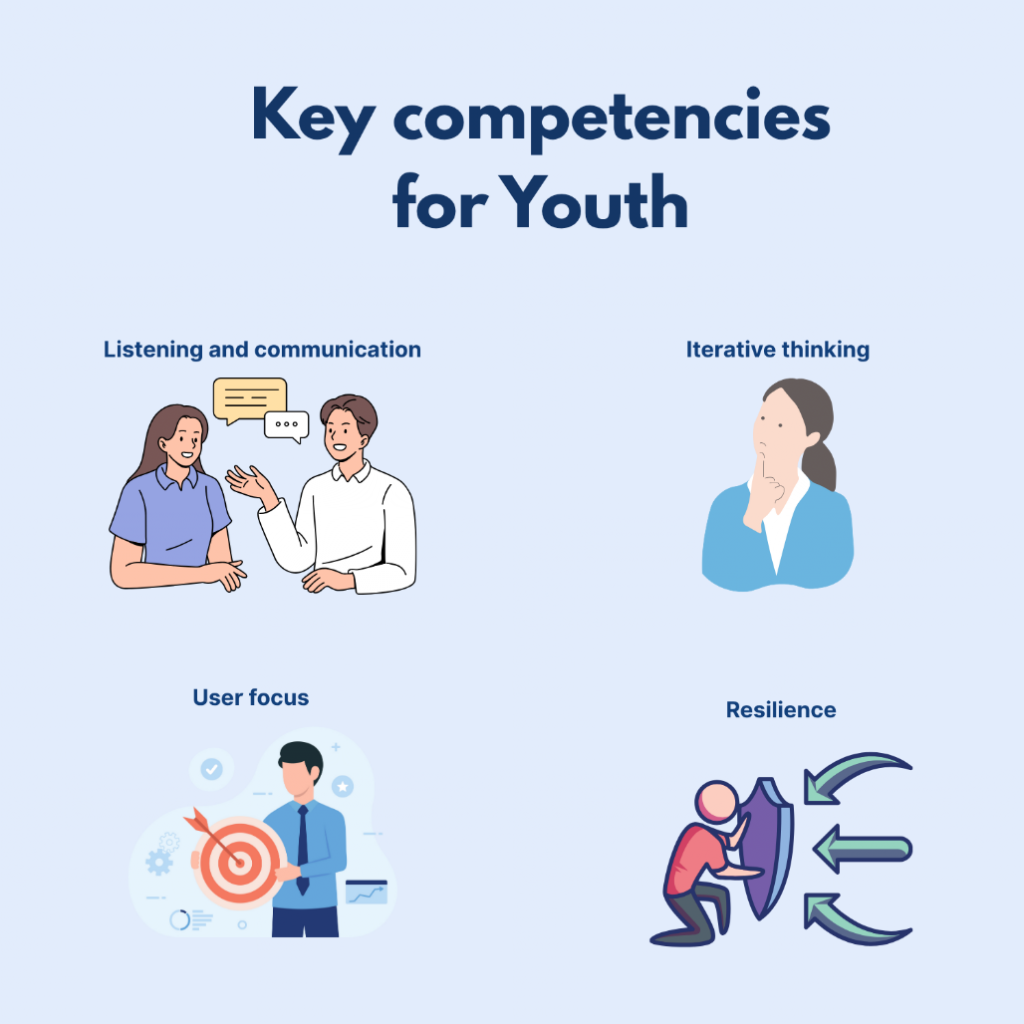
Testing Formats That Work
- Peer Testing – Present ideas or activities to other minors in a safe, informal setting
- User Walkthroughs – Show someone how the project works, step by step, and observe their reactions
- Simple Surveys – Ask 3–5 short questions (e.g. “What did you like?” “What could be better?”)
- Roleplay or Simulation – Act out a service or activity to see how others respond
- Feedback Circles – Present MVPs in a group, then let peers give feedback using positive framing
Note: Staff should coach youth on how to receive feedback—e.g., “Say thank you,” “Don’t defend, just listen.”
Group Activity Example: "Feedback Swap"
- Youth pair up and take turns showing their prototype to each other
- Each gives 2 stars and 1 suggestion (i.e. two things they liked, one idea to improve)
- Repeat with another partner or staff member
- Afterward, youth write 1–2 things they’ll improve based on what they heard
This helps normalize iteration as part of the creative process.

Real-Life Case Example
Rashid, age 17, prototyped a video campaign to raise awareness about youth loneliness. After testing it with peers, he learned that the sound quality made it hard to understand. Instead of being discouraged, he used a free app to improve the audio and added subtitles. The updated version was then shown at the youth center movie night.
Tips for Youth Workers
- Model open, constructive feedback in all activities
- Prepare youth for feedback as an act of trust, not criticism
- Encourage small changes, not full reworks
Questions for self-reflection
Self-reflection is an important part of this course because it helps participants think about their experiences and how they have grown. By taking time to reflect, individuals can better understand not only the current topic, but also their strengths, challenges, and what drives them. This process boosts self-awareness and encourages the use of what they’ve learned in real-life situations, supporting their personal and professional growth.
Reflection Questions for Youth Workers

Part 1
- How can you create a feedback culture where minors feel safe being vulnerable, especially considering their cultural background and personal experiences?
- How can testing and assessment be made fun, interactive, and low-stress, while still respecting different learning styles and cultural norms?
- Are youth learning to ask meaningful, curious questions—rather than just seeking approval or the “right” answer?
- How do different cultural backgrounds shape the way youth perceive feedback, criticism, and failure? How can you adapt your approach accordingly?

Part 2
- What did others think about my idea?
- What feedback was helpful to me?
- How did I feel hearing suggestions to improve?
- What would I do differently next time?
Launch — Formalizing and Sharing the Initiative
Overview
The final stage of the entrepreneurial process is launching—bringing the refined idea into the real world in a meaningful, visible way. For unaccompanied minors, “launch” does not necessarily mean opening a business. It might mean hosting an event, publishing a digital project, running a small service, or even presenting the initiative to a peer group or partner.
The launch is about visibility, recognition, and momentum. It gives youth a tangible sense of achievement, boosts their confidence, and opens the door to collaboration, support, and future steps.
Key Competencies for Youth
- Planning and follow-through – Completing what they started
- Confidence in presentation – Sharing their work publicly
- Navigating procedures – Understanding basic steps to formalize or sustain an initiative
- Networking and outreach – Engaging others to support or participate
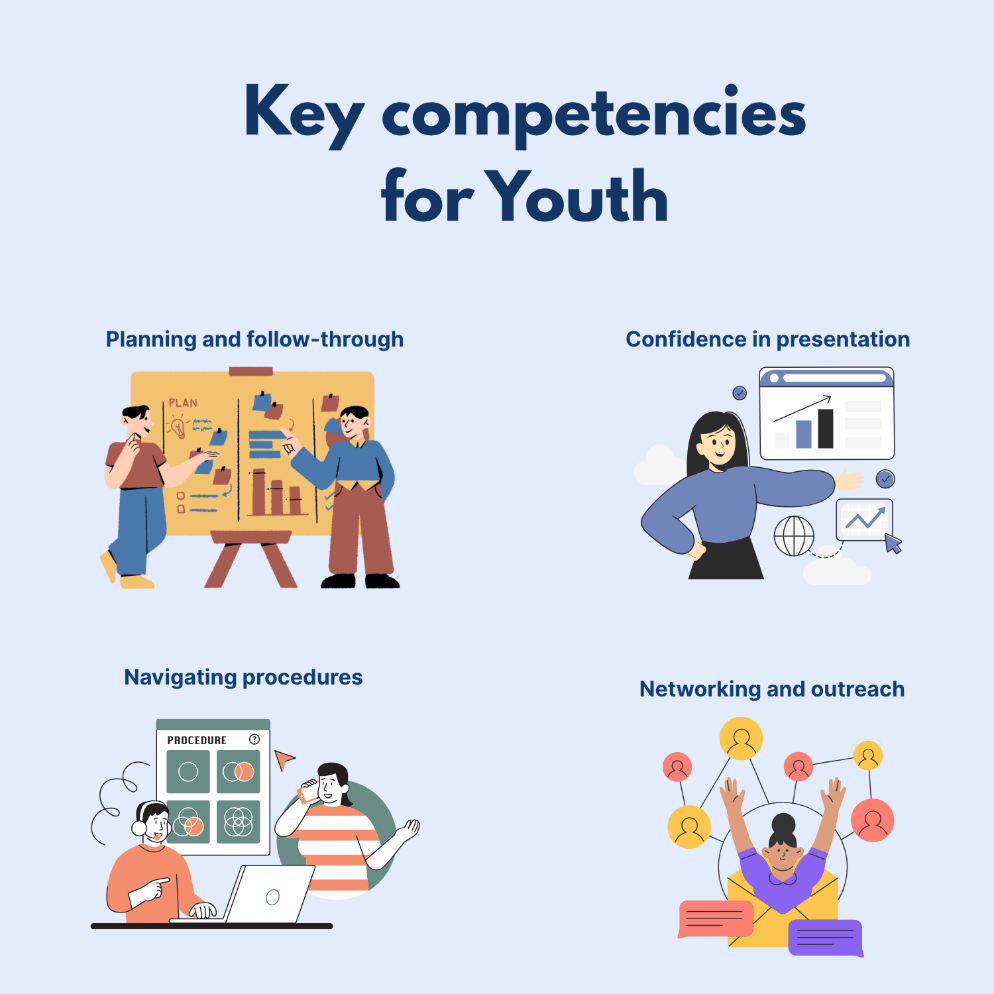
Launch Formats That Work
Depending on the project and the youth’s circumstances, the launch may be:
- A public or private presentation (at the youth center, school, or online)
- A pilot event or activity run for the first time
- A social media campaign
- A printed flyer, digital brochure, or prototype placed in a community space
- A video or story shared with local partners
- Submission of a Letter of Understanding or informal collaboration agreement
For more advanced participants:
- Youth may explore legal registration options, especially if they are close to adulthood and have residence permits. Provide country-specific link for each country’s partner.
Tools and Methods
- Launch Checklist – Define what needs to happen for the launch to succeed (e.g., invite people, print materials, test equipment)
- Visibility Canvas – Help youth think about how to share their work, reach audiences, and celebrate success
- Agreements Templates – Share sample documents like informal team contracts, Letters of Understanding, or partner notes
Group Activity Example: “Mini Launch Week”
- Set aside one week to host a series of youth-led launches
- Each participant or team presents or runs their initiative
- Staff, peers, and external guests (e.g., NGO partners, municipal reps) are invited
- Create “entrepreneurial passports” and stamp them as youth complete stages
This reinforces celebration, documentation, and connection.

Real-Life Case Example
Farah, 18, created a series of short videos sharing her language-learning journey. After several rounds of feedback and revision, she launched a YouTube channel and shared it via the youth center’s newsletter. As a result, she was invited to co-facilitate a language buddy program—and felt, for the first time, that her voice had reach and value.
Tips for Youth Workers
- Frame launch as a milestone, not a finish line
- Encourage documentation: photos, testimonials, certificates
- Support next steps: Could this initiative continue? Grow? Inspire others?
Questions for self-reflection
Self-reflection is an important part of this course because it helps participants think about their experiences and how they have grown. By taking time to reflect, individuals can better understand not only the current topic, but also their strengths, challenges, and what drives them. This process boosts self-awareness and encourages the use of what they’ve learned in real-life situations, supporting their personal and professional growth.
Reflection Questions for Youth Workers

Part 1
- How can you support youth in sharing their initiative with pride and clarity?
- What are ways to document and celebrate small wins, even for informal projects?
- How can your center help sustain or connect youth initiatives to longer-term opportunities?

Part 2
- What does it mean to me to share my project?
- How did I grow as a person from this experience?
- Who supported me in this journey?
- What would I like to create or try next?
Case Study
Case Study 1: Leyla's Storytelling Night
Scenario:
Leyla is a 16-year-old refugee from Syria living in a youth shelter. She loves writing and has started sharing her poetry with friends. She dreams of creating a “storytelling night” where youth from different cultures can share stories, poems, or experiences.
Leyla has a great idea, but she faces challenges:
– The youth center has limited space and no formal event planning process
– Some peers feel shy or afraid to share personal stories
– She’s unsure how to promote the event or get others involved
Guiding Questions:
- What steps should Leyla take to start planning her storytelling night?
- How can she make the event inclusive and safe for all participants?
- What resources might she need, and where could she find them?
- What are small ways she could test her idea before a full launch?
- How can youth workers support her initiative without taking control of it?
Case Study 2
Case Study 2: Jamal’s Community Corner
Scenario:
Jamal, age 16 from Sudan, noticed that many minors at the shelter often sit alone or use their phones all day. He believes a shared community space with games, music, and relaxing decorations could help others feel more connected.
He wants to propose creating a “Community Corner” but runs into obstacles:
– He doesn’t have a budget
– He’s not sure how to get permission
– Some staff are skeptical about whether youth will maintain the space
Guiding Questions:
- How can Jamal present his idea to staff in a convincing way?
- What low-cost or no-cost options could help bring the idea to life?
- How can he involve other youth to build a sense of ownership?
- What can be done to maintain and sustain the space once it’s launched?
Case Study 3
Case Study 3: Amin’s Food Waste Project
Scenario:
Amin, 17, wants to address food waste at the youth center. He and his friends often see uneaten food being thrown away. He suggests setting up a labeled “leftover-sharing box” in the common area so others can take what they need.
His idea is met with mixed reactions:
– Some youth think it’s embarrassing
– Staff raise hygiene concerns
– He doesn’t know how to communicate the purpose effectively
Guiding Questions:
- What are the key ethical and practical issues Amin needs to consider?
- How can he gather input to improve or adapt his idea?
- What might be a small pilot test to try the idea safely?
- How could he reframe the idea to reduce stigma and increase acceptance?
- Who could he partner with to gain credibility or support?
References & Further Reading
Further Reading
Amin, 17, wants to address food waste at the youth center. He and his friends often see uneaten food being thrown away. He suggests setting up a labeled “leftover-sharing box” in the common area so others can take what they need.
Further Reading – Tools and Methods
This section provides links to practical tools and templates mentioned throughout the module. These resources support youth workers in facilitating each stage of the entrepreneurial journey with unaccompanied refugee minors.
🔹 General Toolkits and Canvas Repositories
- Nordic Digital Inclusive Entrepreneurship Program Toolkits
Includes the Dream Life Canvas, World Shift Canvas, Identify Canvas, Team Canvas, Happy Startup Canvas, Business Model Canvas (youth version), and more.
🔗 https://vcc.vifin.dk/course/nep
(For editable canvases: Google Docs repository) - EntreTime Canvas Tools and Training Resources. A comprehensive set of tools for entrepreneurial learning including coaching formats, systemic thinking methods, and reflection exercises. 🔗 https://entretime.eun.org
🧭 Stage-Specific Tools
1. Introduction to Entrepreneurship
- Dream Life Canvas
- World Shift Canvas 🔗 https://vcc.vifin.dk/course/nep#module1
2. Understand – Identifying Needs
- Identify Canvas
- Empathy Interview Worksheet
- Observation Walk Guidelines 🔗 https://vcc.vifin.dk/course/nep#module2
3. Ideate – Generating Ideas
- Crazy 8s Template
- Mind Mapping Tool (Free Online):
🔗 https://www.mindmup.com - What If Canvas (customizable in Canva) 🔗 https://www.canva.com
4. Decide – Choosing a Direction
- Feasibility/Impact Matrix Template
- Decision Canvas (NEP) 🔗 https://vcc.vifin.dk/course/nep#module3
5. Prototype – Build an MVP
- Happy Startup Canvas
- Business Model Canvas (youth version)
- Craft Your Pitch Canvas 🔗 https://vcc.vifin.dk/course/nep#module5
6. Test – Gathering Feedback
- 2 Stars and 1 Suggestion Feedback Template
- Peer Testing Guide 🔗 EntreTime Coaching Module
7. Launch – Sharing and Formalizing
- Visibility Canvas
- Launch Checklist
- Letter of Understanding Template
- Vesting Contract Template (Youth Adapted) 🔗 https://drive.google.com/drive/folders/1hfsp1QEfVSSZODephAvqiTcORaQs9DVO?usp=sharing
References
- Bacigalupo, M., Kampylis, P., Punie, Y., & Van den Brande, G. (2016). EntreComp: The Entrepreneurship Competence Framework. European Commission, Joint Research Centre.
- Gedeon, S. A. (2014). Application of Best Practices in University Entrepreneurship Education: Designing a New MBA Program. European Journal of Training and Development, 38(3), 231–253.
- Westerberg, M., Huxtable-Thomas, L., & Singer, S. (2021). EntreTime Modules 1–7. Erasmus+ Knowledge Alliance.
- Ramaswamy, V., & Gouillart, F. (2010). The Power of Co-Creation: Build It with Them to Boost Growth, Productivity, and Profits. Free Press.
- Dweck, C. (2006). Mindset: The New Psychology of Success. Random House.
- IDEO (2012). Design Thinking for Educators Toolkit. IDEO.
- Sailer, K. (2021). Systemic Thinking for Entrepreneurial Educators. Strascheg Center for Entrepreneurship.
- GIZ (2019). Refugee Entrepreneurship: Practical Insights from Supporting Organizations. Deutsche Gesellschaft für Internationale Zusammenarbeit (GIZ) GmbH.
